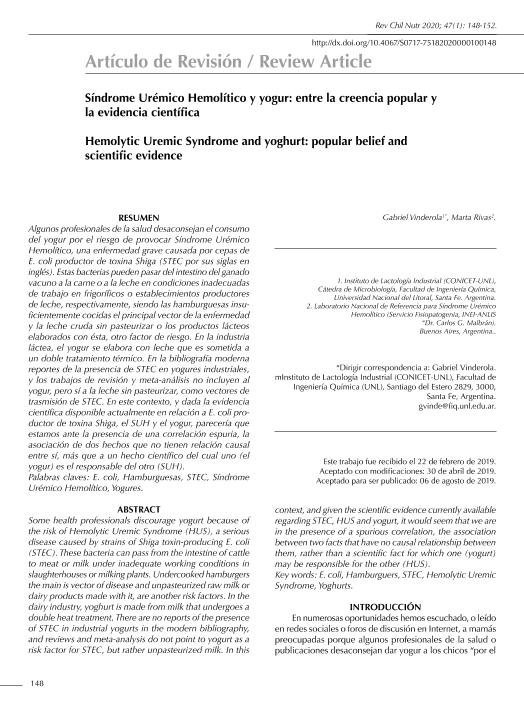Mostrar el registro sencillo del ítem
dc.contributor.author
Vinderola, Celso Gabriel

dc.contributor.author
Rivas, Marta

dc.date.available
2020-10-27T20:53:07Z
dc.date.issued
2020-02
dc.identifier.citation
Vinderola, Celso Gabriel; Rivas, Marta; Síndrome Urémico Hemolítico y yogur: entre la creencia popular y la evidencia científica; Sociedad Chilena de Nutrición, Bromatología y Toxicología; Revista Chilena de Nutricion; 47; 1; 2-2020; 148-152
dc.identifier.issn
0717-7518
dc.identifier.uri
http://hdl.handle.net/11336/116976
dc.description.abstract
Some health professionals discourage yogurt because of the risk of Hemolytic Uremic Syndrome (HUS), a serious disease caused by strains of Shiga toxin-producing E. coli (STEC). These bacteria can pass from the intestine of cattle to meat or milk under inadequate working conditions in slaughterhouses or milking plants. Undercooked hamburgers the main is vector of disease and unpasteurized raw milk or dairy products made with it, are another risk factors. In the dairy industry, yoghurt is made from milk that undergoes a double heat treatment. There are no reports of the presence of STEC in industrial yogurts in the modern bibliography, and reviews and meta-analysis do not point to yogurt as a risk factor for STEC, but rather unpasteurized milk. In this context, and given the scientific evidence currently available regarding STEC, HUS and yogurt, it would seem that we are in the presence of a spurious correlation, the association between two facts that have no causal relationship between them, rather than a scientific fact for which one (yogurt) may be responsible for the other (HUS).
dc.description.abstract
Algunos profesionales de la salud desaconsejan el consumo del yogur por el riesgo de provocar Síndrome Urémico Hemolítico, una enfermedad grave causada por cepas de E. coli productor de toxina Shiga (STEC por sus siglas en inglés). Estas bacterias pueden pasar del intestino del ganado vacuno a la carne o a la leche en condiciones inadecuadas de trabajo en frigoríficos o establecimientos productores de leche, respectivamente, siendo las hamburguesas insu-ficientemente cocidas el principal vector de la enfermedad y la leche cruda sin pasteurizar o los productos lácteos elaborados con ésta, otro factor de riesgo. En la industria láctea, el yogur se elabora con leche que es sometida a un doble tratamiento térmico. En la bibliografía moderna reportes de la presencia de STEC en yogures industriales, y los trabajos de revisión y meta-análisis no incluyen al yogur, pero sí a la leche sin pasteurizar, como vectores de trasmisión de STEC. En este contexto, y dada la evidencia científica disponible actualmente en relación a E. coli pro-ductor de toxina Shiga, el SUH y el yogur, parecería que estamos ante la presencia de una correlación espuria, la asociación de dos hechos que no tienen relación causal entre sí, más que a un hecho científico del cual uno (el yogur) es el responsable del otro (SUH).Palabras claves: E. coli, Hamburguesas, STEC, Síndrome Urémico Hemolítico, Yogures.
dc.format
application/pdf
dc.language.iso
spa
dc.publisher
Sociedad Chilena de Nutrición, Bromatología y Toxicología
dc.rights
info:eu-repo/semantics/openAccess
dc.rights.uri
https://creativecommons.org/licenses/by-nc-sa/2.5/ar/
dc.subject
E.COLI
dc.subject
HAMBURGUERS
dc.subject
HEMOLYTIC UREMIC SYNDROME
dc.subject
STEC
dc.subject
YOGHURTS
dc.subject.classification
Alimentos y Bebidas

dc.subject.classification
Otras Ingenierías y Tecnologías

dc.subject.classification
INGENIERÍAS Y TECNOLOGÍAS

dc.title
Síndrome Urémico Hemolítico y yogur: entre la creencia popular y la evidencia científica
dc.title
Hemolytic uremic syndrome and yoghurt: Popular belief and scientific evidence
dc.type
info:eu-repo/semantics/article
dc.type
info:ar-repo/semantics/artículo
dc.type
info:eu-repo/semantics/publishedVersion
dc.date.updated
2020-10-14T21:19:44Z
dc.journal.volume
47
dc.journal.number
1
dc.journal.pagination
148-152
dc.journal.pais
Chile

dc.description.fil
Fil: Vinderola, Celso Gabriel. Consejo Nacional de Investigaciones Científicas y Técnicas. Centro Científico Tecnológico Conicet - Santa Fe. Instituto de Lactología Industrial. Universidad Nacional del Litoral. Facultad de Ingeniería Química. Instituto de Lactología Industrial; Argentina
dc.description.fil
Fil: Rivas, Marta. Instituto Nacional de Enfermedades Infecciosas; Argentina
dc.journal.title
Revista Chilena de Nutricion
dc.relation.alternativeid
info:eu-repo/semantics/altIdentifier/doi/http://dx.doi.org/10.4067/S0717-75182020000100148
dc.relation.alternativeid
info:eu-repo/semantics/altIdentifier/url/https://scielo.conicyt.cl/scielo.php?script=sci_arttext&pid=S0717-75182020000100148
Archivos asociados
